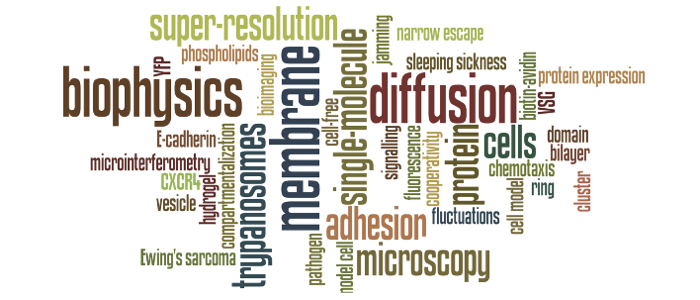Susanne Fenz
“Nothing in life is to be feared; it is only to be understood.” Marie Sklodowska Curie

Susanne Fenz
... is a physicist interested in membrane biophysics of living cells and biomimetic model systems. She studied physics in Würzburg and Heidelberg. For her PhD she moved to the Research Center Jülich where she worked in the laboratory of Rudolf Merkel. There, she developed a biomimetic model system for cell–cell adhesion and combined micro-interferometry with fluorescence wide-field microscopy to study structure and dynamics of adhesion clusters. In 2009 she moved to Leiden University in the Netherlands as a post-doctoral fellow to work with Thomas Schmidt on single-molecule fluorescence microscopy of living cells to investigate the molecular mechanisms of chemotaxis. As a junior group leader at the Biocenter in Würzburg, her current interests include biomimetics, cell adhesion, membrane biophysics of African trypanosomes, and super-resolution microscopy.
since 2012 Junior Group Leader, University of Würzburg
2010 – 2012 Marie Curie Fellow, Leiden University
2009 – 2010 NWO fellow, Leiden University
2009 Postdoctoral Fellow, Research Center Jülich
2009 Dr. rer. nat, University of Bonn
2005 – 2009 PhD work at the Research Center Jülich
susanne.fenz(at)uni-wuerzburg.de
Tel +49 93131 89712
Skype susannefenz
Research synopsis
Susanne Fenz entered the field of biophysics through optics development. Problem-driven technical advances are still actively pursued in her group. Only recently, super-resolution microscopy of intrinsically fast moving flagellates was established motivated by the objective to investigate membrane processes in living trypanosomes. It could be shown that both structural imaging and single-molecule dynamics are now accessible at high spatial and temporal resolution, respectively.
Building on the expertise to analyze single-molecule dynamics in the context of signaling and transcription, current activities focus on the shielding function of the VSG coat of African trypanosomes. In order to fulfill its function this coat has to be simultaneously extremely dense and highly dynamic. To elucidate how these seemingly contradictory properties are achieved, dynamics of the VSG coat are investigated in vivo at the single-molecule level. Of particular concern are the interplay of the GPI-anchored protein coat with the structure and dynamics of the lipid matrix itself.
The VSG coat can only be exo- and endocytosed in a small membrane invagination at the base of the flagellum, the so-called flagellar pocket. This scenario is reminiscent of the narrow escape problem (NEP) dealing with Brownian particles confined to a given domain with reflecting borders and only a small opening where the particles are absorbed. NEP is studied in vivo in trypanosomes as well as in vitro in micro-structured solid-supported lipid bilayers (SLBs). Model systems such as SLBs and giant unilamellar vesicles (GUVs) allow one to identify the contribution of physical parameters to biological processes. Starting with the development of a model system to study cell-cell adhesion various parameters including membrane fluidity and receptor mobility were identified in the past decade. Only recently, it was found that bending fluctuations of membranes are a source of long-range cis-interactions between cadherins, and regulate their trans-interactions. This regulation relies on physical principles and not on details of protein-protein interactions. These omnipresent fluctuations can thus act as a generic control mechanism in all types of cell adhesion.
Recent Publications
Bartossek T, Jones NG, Schäfer C, Cvitković M, Glogger M, Mott HR, Kuper J, Brennich M, Carrington M, Smith A-S, Fenz S, Kisker C, Engstler M. Structural basis for the shielding function of the dynamic trypanosome VSG coat, Nature Microbiology, doi: 10.1038/s41564-017-0013-6.
Fenz S, Bihr T, Schmidt D, Merkel R, Sengupta K, Seifert U, Smith A.-S. (2017), Membrane fluctuations mediate lateral interaction between cadherin bonds, Nature Physics, doi: 10.1038/NPHYS4138.
Fenz S, Smith A.-S., Monzel C. (2017) Measuring the invisible – Determining the size of growing nanodomains using the “inverse FCS”. Biophysical Journal, doi: 10.1016/j.bpj.2017.04.014.
Glogger M., Subota I., Pezzarossa A., Denecke A.-L., Carrington M., Fenz S.F., Engstler M. (2017) Facilitating trypanosome imaging, Experimental Parasitology, doi: 10.1016/ j.exppara.2017.03.010.
Glogger M, Stichler S, Subota I, Bertlein S, Spindler M-C, Tessmar J, Groll J, Engstler M, Fenz S (2017) Live-cell super-resolution imaging of intrinsically fast moving flagellates, Journal of Physics D: Applied Physics, doi: 10.1088/1361-6463/aa54eb
Beletkaia E, Fenz S, Pomp W, Snaar-Jagalska B. E., Hogendoorn P. W.C., Schmidt T (2016) CXCR4 signaling is controlled by immobilization at the plasma membrane, BBA: Molecular Cell Research, doi: 10.1016/j.bbamcr.2015.12.020
Hartel AJW, Glogger M, Jones NG, Abuillan W, Batram C, Hermann A, Fenz SF, Tanaka M, Engstler M (2016) N-glycosylation enables high lateral mobility of GPI-anchored proteins at a molecular crowding threshold. Nature Communications, doi: 10.1038/ncomms12870.








